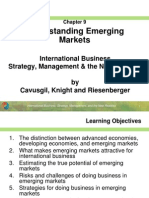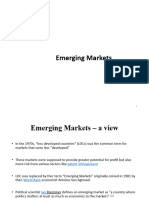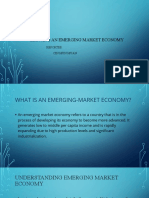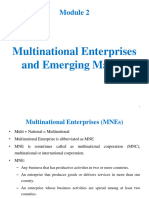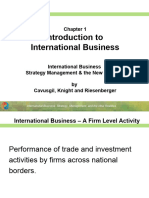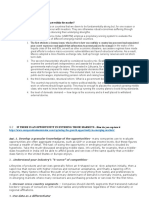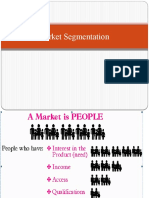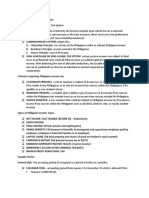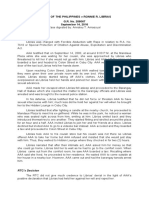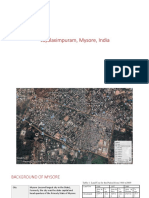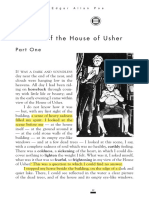11-03-2019
Emerging Markets
International Business R Sugant
In this session
What are emerging markets?
Key factors affecting economic & financial
risks in emerging markets
Entering into emerging markets
International Business 2 R Sugant
1
� 11-03-2019
What are emerging markets?
Countries which are in transition from
developing to developed markets due to
Rapid growth and industrialisation
Countries that have
Started an economic reform process
Achieved a steady GDP growth
Increased integration to global economy
Demographic advantage
International Business 3 R Sugant
Characteristics of emerging markets
Source:
https://www.spice-indices.com/idpfiles/spice-
assets/resources/public/documents/725551_spdji2018countryclassificationconsultation6.13.18.pdf
International Business 4 R Sugant
2
� 11-03-2019
Exchange Development Ratio
𝐹𝑢𝑙𝑙 𝑑𝑜𝑚𝑒𝑠𝑡𝑖𝑐 𝑚𝑎𝑟𝑘𝑒𝑡 𝑐𝑎𝑝𝑖𝑡𝑎𝑙𝑖𝑠𝑎𝑡𝑖𝑜𝑛 𝑜𝑓 𝑡ℎ𝑒 𝐸𝑥𝑐ℎ𝑎𝑛𝑔𝑒
𝐸𝑥𝑐ℎ𝑎𝑛𝑔𝑒 𝑑𝑒𝑣𝑒𝑙𝑜𝑝𝑚𝑒𝑛𝑡 𝑟𝑎𝑡𝑖𝑜 =
𝐶𝑜𝑢𝑛𝑡𝑟𝑦 ′ 𝑠 𝑃𝑃 𝐺𝐷𝑃
in US$ Trill
M-Cap of Bombay Stock Exchange in April 2018 2.3
PP GDP of India - 2017 9.4
Exchange Development Ratio 24%
in US$ Bill
M-Cap of Nigeria Stock Exchange in May 2018 37.94
PP GDP of Nigeria - 2017 1118
Exchange Development Ratio 3%
International Business 5 R Sugant
S&P
Source:
https://www.spice-indices.com/idpfiles/spice-
assets/resources/public/documents/725551_spdji2018countryclassificationconsultation6.13.18.pdf
International Business 6 R Sugant
3
� 11-03-2019
Morgan Stanley
Source:
International Business https://www.msci.com/market-cap-weighted-indexes
7 R Sugant
Advanced Emerging Secondary Emerging
FTSE Markets Markets
Brazil Chile
Czech Republic China
Greece Colombia
Hungary Egypt
Malaysia India
Mexico Indonesia
South Africa Kuwait
Pakistan
Peru
Philippines
Qatar
Russia
Saudi Arabia
UAE
Source:
https://www.ftse.com/products/downloads/FTSE_Equity_Country_Classification_Paper.pdf
International Business 8 R Sugant
4
� 11-03-2019
Source:
https://www.lazardassetmanagement.com/docs/-p94-/33763/ChangingForTheBetter-ALong-
TermCaseFor_en.pdf
International Business 9 R Sugant
EM7 or E7
Brazil, China, India, Indonesia, Mexico, Russia
and Turkey account for
25 percent of global GDP
50 percent of the world’s population
around 60 percent of the consumption of metals
40 percent of the consumption of energy and
food
Source:
http://pubdocs.worldbank.org/en/184021526414119243/Global-Economic-Prospects-June-2018-Topical-
Issue-global-commodity-demand.pdf
International Business 10 R Sugant
5
� 11-03-2019
G7
Canada
England
France
Germany
Italy
Japan
USA
Average growth 1996-2016
Source:
http://pubdocs.worldbank.org/en/184021526414119243/Global-Economic-Prospects-June-2018-Topical-
International Business
Issue-global-commodity-demand.pdf 11 R Sugant
Source:
https://www.pwc.com/gx/en/world-2050/assets/pwc-the-world-in-2050-full-report-feb-2017.pdf
International Business 12 R Sugant
6
� 11-03-2019
Key Factors affecting Economic &
Financial Risks in Emerging Markets
Institutional voids
Infrastructure gaps
Business groups & Family owned SMEs
International Business 13 R Sugant
Institutional Voids
Inefficiencies in capital product and labour
markets
Financial institutions
Information regarding consumers/
consumption habits not widely available
Increases cost of operations
Ease of Doing Business
Incentives help in overcoming constraints
International Business 14 R Sugant
7
� 11-03-2019
Infrastructure gaps
Public utilities
Public works
Transport
Inefficient distribution, logistics/
supply chain
International Business 15 R Sugant
Business Groups & Family owned SMEs
Ownership
As a response to institutional inefficiencies
For ex., Brazil's economy is concentrated within
12 corporations that represent more than 50% of
the total wealth generated by all listed companies
In India, 15 of the top 20 business groups are
family owned
International Business 16 R Sugant
8
� 11-03-2019
Entering into Emerging Markets - The
fallacy of Indices
Index Brazil Russia India China South Africa
Ease of Doing Business 1 109 31 77 46 82
Global Innovation Index 2 33.2 38.5 33.6 50.6 35.8
Gini Index 3 51.3 37.7 35.2 42.2 63.4
Corruption Perception Index - 2017 4 96 135 81 77 71
Country Risk Index 5 56.9 61.2 63.6 68.7 55.2
Human Development Index Ranking 6 79 49 130 86 113
1 - Source - World Bank: www.doingbusiness.org
2 - In 2016.
Source:https://iorj.hse.ru/data/2018/05/23/1149410200/Innovation%20development%20of%20the%20BRICS%20countries.pdf
3 - Gini Index - Higher the index, more the inequality. Source:
https://www.theguardian.com/inequality/datablog/2017/apr/26/inequality-index-where-are-the-worlds-most-unequal-countries
4 - Rank out of 180 countries Source:
Source: https://www.transparency.org/news/feature/corruption_perceptions_index_2017
5 - Composite of operational, economic and political risk; High nos. indicate more stability. Source:
https://www.marsh.com/content/marsh/political-risk-map-d3/prm-2018.html
6 - Lower the rank, better the human development. Source:
International Business 17
https://en.wikipedia.org/wiki/List_of_countries_by_Human_Development_Index#/media/File:2018_HDI.svg R Sugant
Entering into Emerging Markets –
More differences than similarities
Population
Density (per sq.
km) *
24.2
8.6
386
143.6
46
* Source: BRICS Joint Statistical Publication – 2017; http://www.gks.ru/free_doc/doc_2017/JSP-2017.pdf
International Business 18 R Sugant
9
� 11-03-2019
Entering into emerging markets –
Do’s
1. Target urban
growth clusters
Focus on Tier 2
cities
Source: Winning the $30 Trillion Decathlon - A reporty by
International Business 19 McKinsey & Company, 2012 R Sugant
International Business 20 R Sugant
10
� 11-03-2019
Entering into emerging markets –
Do’s
2. Anticipate moments of explosive growth
Staples/ snacks/ consumer durables/ luxury
goods
3. Devise segmentation strategies for local
relevance and global scale
Identify niches, customize products
Source: Winning the $30 Trillion Decathlon - A reporty by
International Business 21 McKinsey & Company, 2012 R Sugant
Entering into emerging markets –
Do’s
4. Deploy resources for the long term
5. Innovate to deliver value across the price
spectrum
Source: Winning the $30 Trillion Decathlon - A reporty by
McKinsey & Company, 2012
International Business 22 R Sugant
11
� 11-03-2019
Entering into emerging markets –
Do’s
6. Build brands that inspire trust
7. Control the route to market
Xiaomi creates a new GUINNESS WORLD RECORD,
by launching 500+ rural Mi Stores in India!
Source: Winning the $30 Trillion Decathlon - A reporty by
McKinsey & Company, 2012
International Business 23 R Sugant
Entering into emerging markets –
Do’s
8. Organise today for the market of tomorrow
9. Turbocharge the drive for emerging market
talent
10. Lock-in the support of key stakeholders
Source: Winning the $30 Trillion Decathlon - A reporty by
McKinsey & Company, 2012
International Business 24 R Sugant
12
� 11-03-2019
To recap
What are emerging markets?
Definition
Characteristics
S&P, Morgan Stanley, FTSE
Key factors affecting economic & financial risks in
emerging markets
Institutional voids
Infrastructure gaps
Business groups & Family owned SMEs
Entering into emerging markets
Fallacies
Do’s
International Business 25 R Sugant
13


